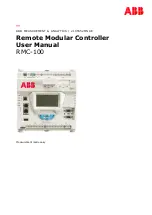
10
| RMC-100| 2105552MNAE
—
1
System description
The Remote Modular Controller (RMC-100) provides measurement, automation, monitoring, alarming,
asset data management, control, and data logging applications. A single RMC-100 controller can
manage automation, liquids and gas measurement, and asset data concentration for very large
production and transmission facilities.
1.1
Features overview
The RMC provides backward-compatible functionality based on ABB Totalflow software,
communications, and I/O technologies. The existing process foundation and the new enhanced
technology manage liquid and gas measurement, automation, and asset data concentration for large-
scale production and transmission facilities. It is scalable down to a single-board RTU footprint for
smaller systems.
The RMC supports I/O and communication expansion.
The RMC supports dual, backward-compatible TFIO buses, doubling the I/O module capacity to 44
modules.
The table below provides the general specifications for the RMC.
Table 1-1: General specifications
Specification
Description
Operating voltage
range
12 – 24 Vdc (+/- 20% variation, acceptable input range 9 – 30 Vdc). All voltage
output connections of both the onboard and TFIO modules depend on the
operating power supply voltage connected to the CHARGER/EXT PWR port.
Nominal power
1.5 watts (5 A maximum with external options connection)
Weight
Minimum (no communication modules inserted): 1.708 lbs. (0.775 kg)
Maximum (both communication modules inserted): 1.816 lbs. (0.824 kg)
Dimensions
Width
7.56 inches (19.20 cm)
Height
8.31 inches (21.11 cm)
Depth
1.72 inches (4.37 cm)
Installed Depth
On DIN rail 1.79 inches (4.55 cm)
Input/Output
6 DI/DO, 2 PI, 4 AI, and 1 AO
Maximum battery
capacity
30 Ah
Mounting
DIN rail mounts on a wall or enclosure that meets the environmental ratings for
the environment of the location
Operating
temperature
-40 °C to 60 °C (-40 °F to 140 °F) when used with battery
-40 °C to 70 °C (-40 °F to 158 °F) when no battery is used
Storage temperature of -40 °C to 85 °C (-40 °F to 185 °F)
Electromagnetic
compatibility
Emissions (Other):
FCC CFR 47, Part 15, Subpart B, Class A (FCC Emissions)
IECS-03, Issue 4, CAN/CSA-CEI/IEC CISPR 11 Class A (Canada ITE Emissions)
AS/NZS CISPR 11, Class A (Australia/New Zealand)
EMC Directive
2004/108/EC
Emission EN 61326-1: Radiated and conducted Class A
Immunity EN 61326-1 to:
EN 61000-4-2, ESD, 8 kV Air, 4 kV Contact
EN 61000-4-3, RFI, 10 V/m
EN 61000-4-4, EFT, 2 kV to DC, 1 kV to Signals
EN 61000-4-6, Conducted, 0.15-80 MHZ, 3 Vrms
Hazardous location
certification
(North America)
According to standards for the assurance of fundamental safety requirements in
the United States of America:
UL No. 61010-1: "Safety Requirements for Electrical Equipment for
Measurement, Control, and Laboratory Use - Part 1: General Requirements"
ANSI/ISA 12.12.01: "Non-incendive Electrical Equipment for Use in Class I and
II, Division 2 and Class III, Divisions 1 and 2 Hazardous (Classified) Locations."
ANSI/UL 60079-0: "Explosive Atmospheres – Part 0: Equipment – General
Requirements"
ANSI/UL 60079-15: "Explosive atmospheres – Part 15: Equipment protection by
type of protection 'n' "
UL No. 50E: "Enclosures for Electrical Equipment, Environmental

























